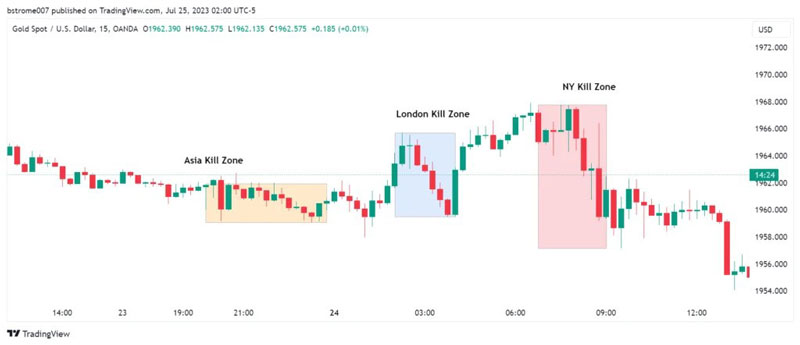What you are about to read:
In the dynamic world of forex trading, experienced traders often use various strategies to identify optimal entry and exit points for their trades. One recognized concept in this regard is the Kill Zone in Forex. This article, a tutorial to learn forex trading from the BrokerLand review site, explores the killzone area, how traders utilize it, and key considerations to maximize its effectiveness.
What is Kill Zone in Forex?
In the field of forex trading, the term “Kill Zone” is not a globally recognized or standardized term. Nevertheless, traders may informally use this term to refer to specific areas on forex charts where significant market movements are anticipated.
Here are a few interpretations that traders may associate with the Killzone term in the forex trading context:
- High Probability Trading Zone: Some traders might use the Kill Zone term to describe a region on the price chart where they believe there is a high probability of a strong market move or a higher likelihood of successful trading. This could be based on technical analysis, including identification of key support and resistance levels, trend lines, or chart patterns.
- Stop-Loss Placement Zone: Alternatively, traders might use the term Kill Zone in forex to indicate an area on the price chart where they set their stop-loss orders. This price level is where a trader is willing to accept a loss to protect their capital if the market moves against their position. The idea is that if the price reaches this zone, the trade is invalidated, and a stop-loss order is triggered.
Understanding the Killzone Area
As mentioned earlier, the term kill zone in forex does not have a standardized global definition. However, it typically involves specific price levels or areas on the chart where traders anticipate significant market movements or execute key trading decisions. Essentially, it signifies a region where trading opportunities are expected to be more abundant, and traders often employ various strategies within this zone.
Identifying the Kill Zone areas
Let’s delve into some points to identify this Zone on forex charts.
Key Support and Resistance Levels
One approach to identifying this area involves analyzing key support and resistance levels on the price chart. These levels represent areas where prices historically have shown a tendency to reverse (Trend Reversals) or experience significant movements. The Killzone area, in this context, may be in proximity to these levels, where traders expect an increase in market activity.
Technical Analysis Tools
Traders often use technical analysis tools such as trendlines, Fibonacci levels, and chart patterns to define this area. The goal for traders is to combine these tools with other forex indicators like moving averages or oscillators, determining areas where multiple factors converge, increasing the likelihood of significant market movements.
Kill Zone during the Asian Session
The Asian session is known for lower overall volatility compared to other forex sessions. These areas during this time may be less distinct, but traders still need to remain vigilant regarding potential setups near key support or resistance levels.
KillZone in the European Session
Overlap between the Asian and European sessions can lead to increased liquidity and volatility. Traders may identify killzone areas during this overlap, especially if technical factors converge near significant price levels.
North American Session
The New York session witnesses a significant increase in trading activity, often resulting in stronger price movements. Traders may find well-defined Kill Zone areas during this session, particularly when the trend continues or reverses.
important forex news
Publication of important forex news related to key economic indicators such as Gross Domestic Product (GDP), employment data, and inflation figures can lead to market fluctuations. Traders may observe the development of Kill Zones around these events as the market reacts to new information.
Statements and decisions from central banks, especially those related to interest rates, can significantly impact currency prices. Traders, in response to central bank announcements, may identify Killzone areas around key support or resistance levels.
Geopolitical events, such as elections or geopolitical tensions, can create market uncertainty and increase volatility. Kill Zones in Forex may undergo reassessment by traders based on evolving geopolitical outlooks.
Forex Kill Zone Strategies
However, is this area suitable for all trading strategies with very high market activity, or are there specific scenarios that may be more beneficial?
Breakout Trading
This area is often associated with breakout trading strategies. Traders may place pending orders just outside the identified Kill Zone and anticipate that a significant price movement beyond support or resistance levels will trigger these orders, leading to profitable trades.
Reversal Strategy
In some cases, this area is used to identify potential reversals in the market. Traders may look for signs of exhaustion in the Killzone, such as overextended trends, divergence in oscillators, or candlestick patterns like the wedge chart pattern, triangle pattern, rectangle pattern, or head and shoulders pattern, indicating a potential reversal. This approach is riskier but can yield substantial profits with accurate reversal predictions.
Risk Management
Regardless of the specific strategy employed in Kill Zone in Forex, effective risk management is crucial. Traders should set stop-loss orders within this area to limit potential losses in case the market moves against their positions and prevent margin calls. This includes precisely determining the risk to reward ratio for each trade and adjusting position size accordingly.
Precautionary Measures
Confirmation Indicators: While the Kill-Zone area may create a potential entry point, relying on confirmation indicators can enhance the accuracy of trading decisions. Confirmation signals from indicators like Relative Strength Index (RSI), Moving Average Convergence Divergence (MACD), or other momentum indicators can provide additional credibility.
Avoid Overtrading: The allure of the Kill Zone in Forex and its perceived potential for profitable trades may tempt traders to overtrade. It’s crucial to maintain discipline and only execute trades when the market aligns with the predetermined criteria of the selected strategy, avoiding impulsive trading based on FOMO (Fear of Missing Out) and emotions. Overtrading can lead to increased transaction costs and higher risks.
Economic News and Events: Traders should pay attention to upcoming economic news and events that may impact the forex market. The killzone area may coincide with these events, leading to increased market volatility and unpredictable price changes. Awareness of the economic calendar can help traders make informed decisions and effectively manage risks.
Backtesting and Analysis: Before implementing a strategy in this area, traders should conduct thorough backtesting and analysis. This involves examining past price data to evaluate the performance of the chosen strategy in various market conditions. Backtesting helps traders gain insights into the strengths and weaknesses of their approach. MetaTrader strategy tester can be utilized for this purpose.
Pros and Cons of Trading in the Killzone
Trading in the Forex Kill Zone, often associated with key support and resistance levels on price charts, comes with a set of advantages and disadvantages. Let’s break down the positive and negative aspects of trading in this area:
Pros
High Probability Trades: The Forex Kill Zone, often located near significant support or resistance levels, can provide high probability setups. Trading in this area can offer settings with a high likelihood, as these levels are where significant market movements often occur.
- Strategic Entry and Optimal Exit Points: Kill Zone in Forex can serve as an optimal entry point for traders using strategies like breakout or reversal. This facilitates precise timing of entry and enhances the potential for profitable trades.
Defined Exit Points: Traders can set clear stop-loss orders in this area, creating predefined exit points that assist in effective risk management. - Technical Analysis Confirmation: This area can be used in conjunction with indicators like RSI, MACD, or others. Confirmation signals from these indicators in the Zone can boost a trader’s confidence in their decision-making process.
- Controlled Risk: Placing stop-loss orders in this area enables traders to control and manage their risk effectively. This is crucial for preserving capital and minimizing potential losses.
Cons
- Increased Volatility: Forex markets are already volatile. The Kill Zone, often located near key levels, is frequently characterized by increased volatility. This heightened market activity can lead to sharp and unexpected price reversals, potentially triggering stop-loss orders.
- Temptation to Overtrade: The perceived high probability settings in this area may tempt traders to overtrade. Excessive trading within a short timeframe can result in increased transaction costs and higher market risks.
- Fake Breakouts and Unpredictable Market Behavior: The Kill Zone in forex is not foolproof, and traders may encounter false breakouts. Unforeseen events or changes in market sentiment can lead to unpredictable behavior within this time and area.
- Changing the interpretation: Identifying this area can be subjective and may vary among traders. Different traders may use different tools or criteria for technical analysis, leading to potential variations in identifying the Kill Zone.
- Market Timing Challenges: Successful trading in this area requires precise market timing. Traders need to skillfully interpret price performance and indicators for optimal real-time execution, which can be challenging, especially for less experienced traders.
Trading in the Killzone is a strategy adopted by many Forex traders seeking strategic entry and exit points based on key support and resistance levels. While it offers advantages such as high-probability trades and strategic entry points, traders must also navigate challenges like increased market volatility, potential false signals, and the risk of overtrading.
Conclusion
In summary, the Kill Zone in Forex is a concept embraced by traders aiming to invest strategically in entry and exit points in the dynamic currency market. While its definition may vary among traders, its essence lies in identifying areas where market activity is expected to intensify, presenting opportunities.
Successfully navigating the Forex market using this approach requires a combination of technical analysis, strategic planning, and disciplined execution. Traders must be aware of the risks associated with heightened volatility in the Kill Zone and employ effective risk management strategies to protect their capital.
Like any trading approach, continuous learning, adaptability, and a commitment to ongoing analysis are essential for traders looking to incorporate this Forex zone into their portfolio. By understanding the dynamics of this concept and integrating it into a well-thought-out trading strategy, traders can potentially enhance their ability to identify and capitalize on profitable opportunities in the Forex market.













